I came to Chicago from London just a few months after the ’68 riots to take a position as an art instructor at Chicago State College. The 60’s were in full swing. American life seemed dynamic and exciting, a roller coaster ride from the troughs of racism and anti-war sentiment to the heights of Utopian thinking, and art in America reflected all the twists and turns of this fast-paced culture.
I met my future wife Jane Addams Allen at Chicago State. She was the grand niece of the famous Chicago social worker Jane Addams, but like me, her perspective on the country was shaped by living many years in Europe.
Jane and I shared a passion for visual art. We were both painters, and our search for new aesthetic adventures soon took us to a college art association conference at the Hilton in Chicago. One of the keynote speakers was Leon Golub, the artist of conscience who spoke intensely of his concern over repression, racism and sexism in America. That intensity was spreading through the art world; and Edward Fry, then the curator of the Guggenheim Museum (later fired for putting up a show of slum properties owned by some museum donors) decided to form a splinter group called The New Art Association.
Follow The Artists
As the first Chicago members, Jane and I were tapped to put out the first regional edition of its art newsletter. Working out of Jane’s apartment in Hyde Park, we mimeographed a 4-page newsletter about the growing art scene in Chicago. This was our first taste of publishing, and the reception encouraged us to believe Chicago was ripe for a free and open discourse about all facets of the arts.
Invited to appear before the Illinois Arts Council, Jane argued for a more liberal approach to individual arts grants. The role of an arts council is to follow the artists not lead them, she said, quoting from Lord Maynard Keynes’ famous address to the British Arts Council. A few days later, Tom Willis, the arts editor of The Chicago Tribune and a great admirer of Keynes, asked Jane and I to become the Tribune art critics.
We worked hard uncovering risky new art in Chicago, never missed a deadline, and enjoyed considerable freedom to follow our own tastes. The arrangement lasted for 18 months. Then without the courtesy of an explanation, we were bumped for Alan Artner, a music student who’d shown little interest in art at the time and a safe, if predictable, guide to the Chicago galleries. We apparently were not.
The New Art Examiner Is Born
But we remained passionate about art criticism so we convinced Art News in New York to commission a piece about Chicago artists appearing in the Sao Paulo Biennial. When that story was spiked (it ran instead in Studio International), we decided the only way to continue writing was to become our own publishers. So in October 1974, The New Art Examiner was born. The cover of the eight-page tabloid carried an editorial titled “Without Fear or Favor.”
For the next 28 years, The New Art Examiner roiled the art scene in Chicago with sharp opinions, outsider perspectives and not a little controversy. Everyone on the staff was paid equally, about half what they deserved, and equally shared in the brickbats and accolades of our readers.
When we started, Chicago was looked upon as an arts backwater. But for young artists, it was a place to be a big fish in a small pond, and no one really cared where the water’s edge lay. I remember Chris Millon’s diving board atop the Federal Building downtown and the Ice House show in an old Soo Line railroad storage facility. I remember the first Art Chicago exhibition at Navy Pier and venturesome new galleries outside the usual Michigan Avenue corridor like N.A.M.E., Artemesia and the Randolph Street Gallery.
The New Art Examiner covered them all with a passion and intelligence that soon gained it a national following. We didn’t care whether the art was good or bad. Our editorial policy was to give writers an opportunity to use their reviews as a springboard for intelligent discussion of larger social issues. Whether deserved or not, our reputation was as a renegade in an otherwise staid art community.
Jane and I stayed with the New Art Examiner until the mid-eighties when, for health and other reasons, not the least financial, we moved to Washington, D.C. We could see a growing age gap between ourselves and the young writers we commissioned. As outsiders in an increasingly insider’s world, we also couldn’t find teaching positions here that would allow us to continue mentoring their work.
A Shift in the Landscape
The art scene has shifted to academia––not only in Chicago but in all the art capitals. Art patrons and their endowments allow art schools to sponsor a variety of new art exhibitions that outsider galleries cannot afford. But the legion of students emerging with BFA and MFA degrees do not necessarily emerge with a professional arts education, especially when it comes to making a living as an artist. They only come out with a better appreciation of what it takes to make their work commercial.
The inner working of the art world, for instance, remains a mystery to most faculty and certainly most graduates. The inside dealers and collectors on the museum trustee circuit, the curators and art historians at museums foster an environment where art only trickles down, not up. Artists looking for a foothold in the market find themselves climbing a ladder to success stripped of the rungs of appreciative reviews that the New Art Examiner used to provide.
Art writing, art criticism and art publishing has once again coalesced in New York, which has regained its status as the epicenter of the art distribution center. But in its prime, “The New Art Examiner was the best thing to have happened in the Chicago art scene in the 70’s and 80’s,” as Franz Schultze recently recalled.
Independent Thinking Dies Slow
The New Art Examiner struggled along in its last ten years under the constant threat of financial foreclosure. In its last days, Lew Manilow, the pre-eminent Chicago art collector, tried to resurrect the publication with a cash infusion. The board appointed an adjunct art professor at the School of the Art Institute graduate, Kathryn Hixon as editor. But the experiment lasted only another 18 months. The publication closed its doors for good in 2002.
Still, The New Art Examiner will not go gently into that good night. This November, the Northern Illinois Press will publish an anthology of articles from the magazine in a book called “The Essential New Art Examiner” by Terri Griffin, Kathryn Born and Janet Koplos.
It features timely articles by Fred Camper, Dan Sultan, James Yood, Ann Weins, Jan Estep, Robert Storr, Carol Diehl, Jerry Saltz, and Carol Squiers that resonate even today.
But the debate over what killed The New Art Examiner will go on. My own view is that it wasn’t one thing, but a change in the art scene itself, a sort of calcifying of the status quo, not unlike the slow transformation of America itself, into a self-satisfied boosterism where independent thinking, running against the grain of people’s comfort zone, no longer has a place in American cultural life, much less the art scene.




